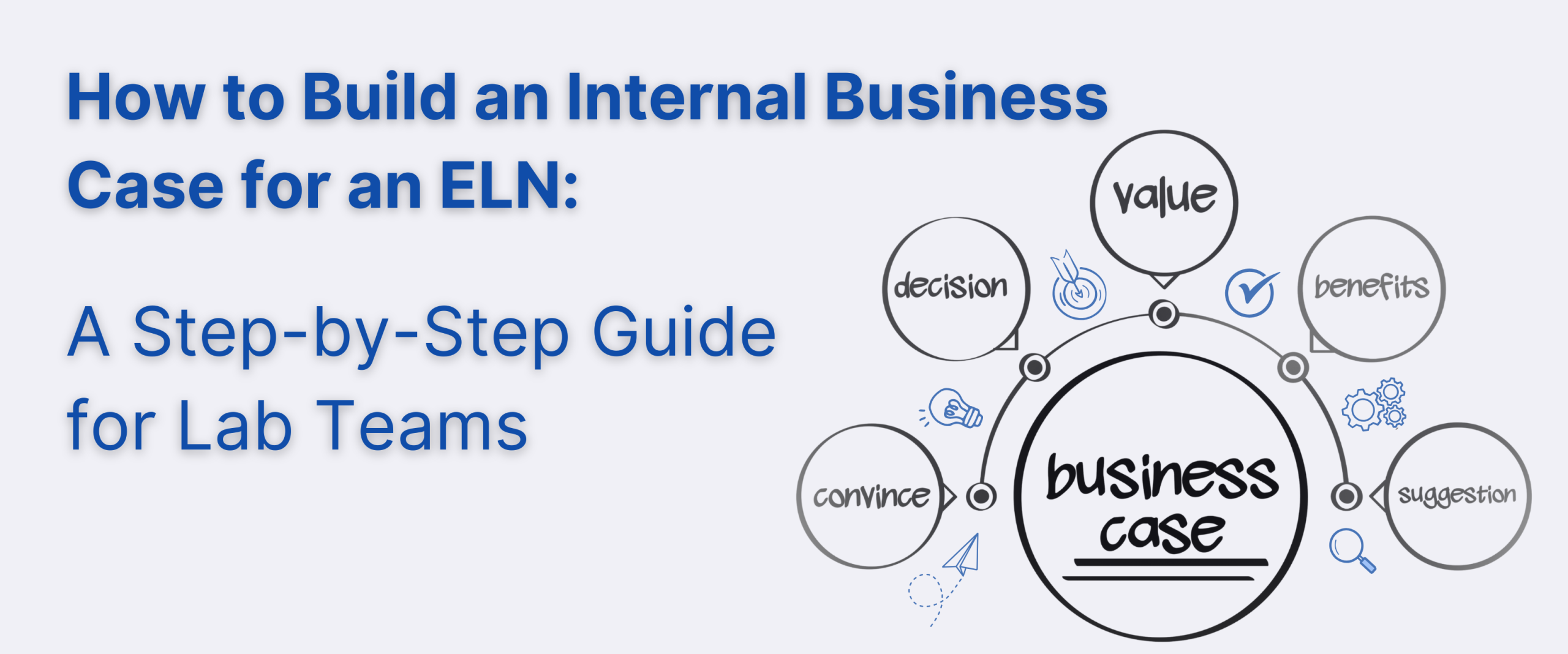How to Build an Internal Business Case for an ELN: A Step-by-Step Guide for Lab Teams (and How to Convince Your Boss)
![]() 5 min read
5 min read
Digital transformation in the lab usually starts with a simple thought:
“There must be a better way to do this.“
If you’ve experienced the frustration of paper notebooks, scattered files, or time-consuming documentation tasks, you’re not alone. Many research teams are now considering the switch to an Electronic Lab Notebook (ELN) to improve efficiency, compliance, and collaboration, but knowing the ELN’s value isn’t always enough.
Often, the biggest barrier is getting your boss or leadership team to sign off.
Whether you’re a researcher, lab manager, postdoc, or team lead, this guide will walk you through the steps for building a clear and compelling business case for an ELN solution like SciNote. It doesn’t need to take weeks. With a little preparation and the right approach, you can make a strong case for change, and lead the charge to a more digital, more productive way of working.
Contents
Step 1: Identify Problems and Inefficiencies in Your Lab
Start by assessing how your lab operates today. What’s slowing your team down, creating friction, or putting your research at risk?
Here are five common pain points we often hear from labs (and real-world examples that may feel familiar):
Begin documenting how often these situations occur. Even simple metrics (e.g., time lost recovering data) can be powerful for a business case.
Begin documenting how often these situations occur. Even simple metrics (e.g., time lost recovering data) can be powerful for a business case.
Step 2: Gather Qualitative and Quantitative Evidence
Next, validate the problems you’ve identified by talking to your team. Conversations with peers can uncover shared frustrations and strengthen your case for change. Even basic numbers, like “5 hours/weeks lost per team member” can show leadership that this is a real, recurring issue.
Ask questions like:
- What frustrates you most when documenting your work?
- Which tasks feel repetitive or error-prone?
- Where do we lose the most time?
Then, try to quantify:
- Time lost per week on admin tasks or data retrieval
- Delays due to missing or inconsistent records
- Frequency of duplicated efforts or miscommunication
- Reliance on workarounds (spreadsheets, cloud folders, sticky notes)
Step 3: Map Problems to ELN Solutions
Now you need to bridge the gap. For each challenge you identify, show how an ELN solution can directly solve it. Here’s an example mapping that helped one of our clients convince their boss:
| Problem | Solution |
|---|---|
| Unable to find protocols and experimental data from 6 months ago | Centralized and searchable database tied to projects and samples |
| Not audit ready | Built in audit trails, version control, and electronic signatures |
| Large number of errors caused by manual input | Linking samples, data, and experiments in one system with the possibility of structured data input. |
| Team spends one day a week reviewing and co-witnessing experimental work. | Improved collaboration with smart links, reminders in app and via email, and comments. |
Step 4: Estimate the ROI (even an estimate helps)
Leadership typically wants to see two things: saved a rough time estimate and reduced risk. Fortunately, ELNs can deliver both.
Try estimating:
- How much time each person could save per week (e.g., 30 minutes/day = 10 hours/week for a 4-person team)
- The cost of errors, delays, or duplicated efforts (emails back and forth, slower product to market, multiple people working on the same work, time spent searching for data)
- Resources saved during audits, grant reporting, or data review
Sample talking points:
- If we save 30 minutes per day per person across the team, we gain 10 hours of research time every week.
- Standardizing our protocols can reduce experiment duplication—and wasted reagents.
- Audit prep could go from 2 weeks of manual effort to just a few hours.
You don’t need perfect estimates—just data that shows the ELN pays for itself in short time frame.
Step 5: Prepare for Objections
When you present your case, anticipate concerns and be ready with your replies.
| This will take too much time to implement. | We can start with less users, run one project/grant, and then slowly expand user numbers. No need for a big rollout right away. On top of that, the solution provider offers customized onboarding, on site visits, and support. |
| People will not use it | The team is already complaining about current processes. We would involve them early on to get buy in and improve adoption. The solution provider also provides change management consultation. |
| It’s too expensive | The long-term value of savings, fewer errors, and better audit/investor prep should pay off quickly. |
If you’re unsure how to reply, ask your vendor for customer references, case studies, or ROI numbers.
Step 6: Summarize in a Clear, Concise Proposal
Once you’ve gathered your insights, prepare a 1–3-page proposal or brief slide deck. Include:
- The challenges your team faces (with examples)
- The impact of these challenges (cost, time, quality)
- How an ELN solution like SciNote can help
- ROI estimation or resource savings
- A proposed next step (e.g., pilot project with one team)
You can download a ready-made business case template or walk through one with our team during a demo.
Step 7: Add Social Proof
If your manager is still on the fence, showing that others have already adopted digital lab platforms can make a big difference.
Examples of social proof:
- 90,000+ scientists use SciNote globally.
- Published case studies from biotech, pharma, and academia.
- References from labs of similar size or regulatory needs.
You’ve Got This!
Convincing your lab to adopt an ELN isn’t just an operational move, it’s a leadership action. It shows initiative, foresight, and a genuine desire to improve how your team works.
By clearly identifying your lab’s current pain points, linking them to practical ELN benefits, and proposing a smart plan, you’ll be prepared to pitch your idea with confidence.
Need help preparing your internal case or getting your team on board?
We’re here to help.

Ready to start building your case? We’re here to help.
Let us show you how SciNote can streamline and support your workflows




